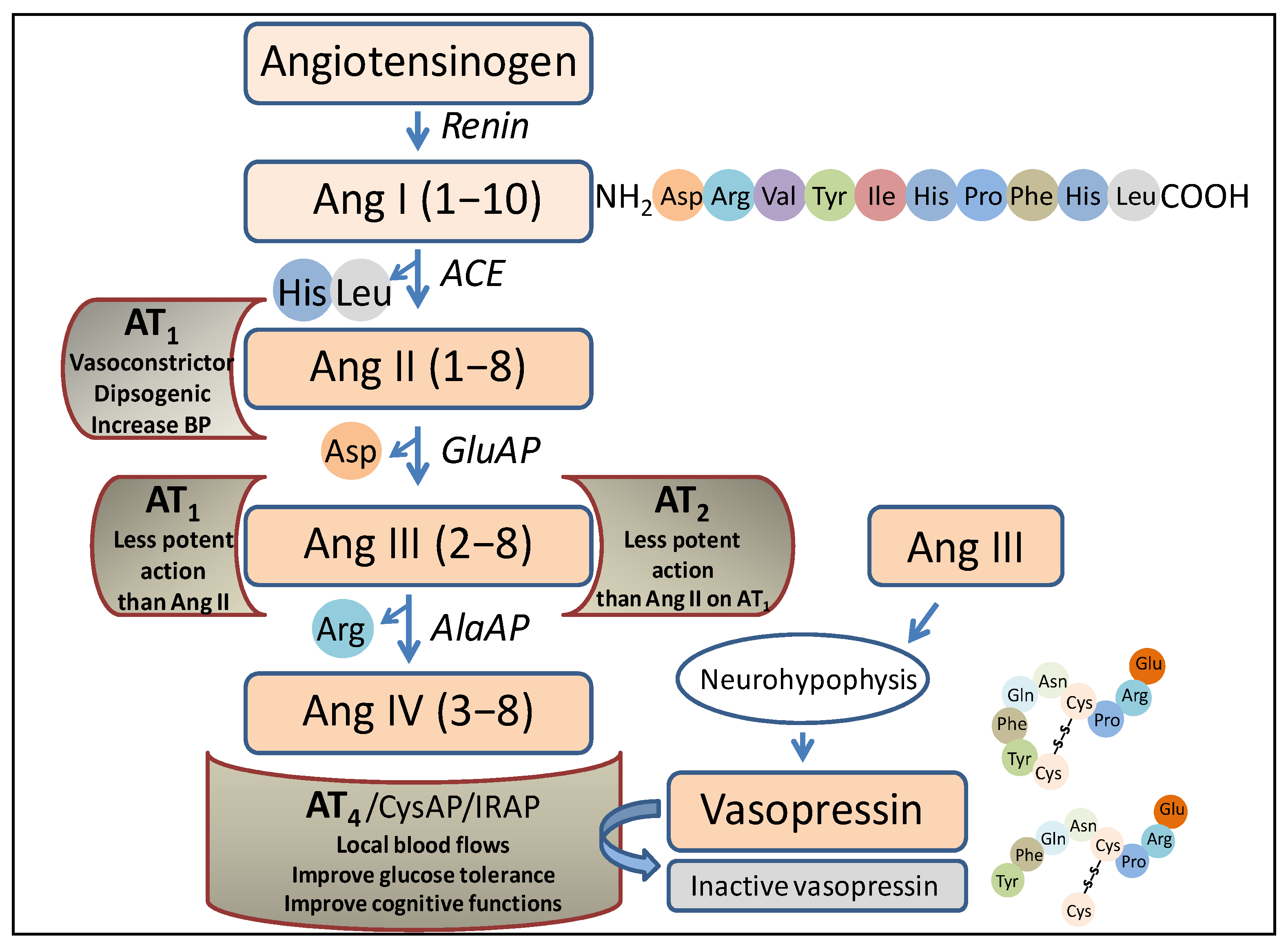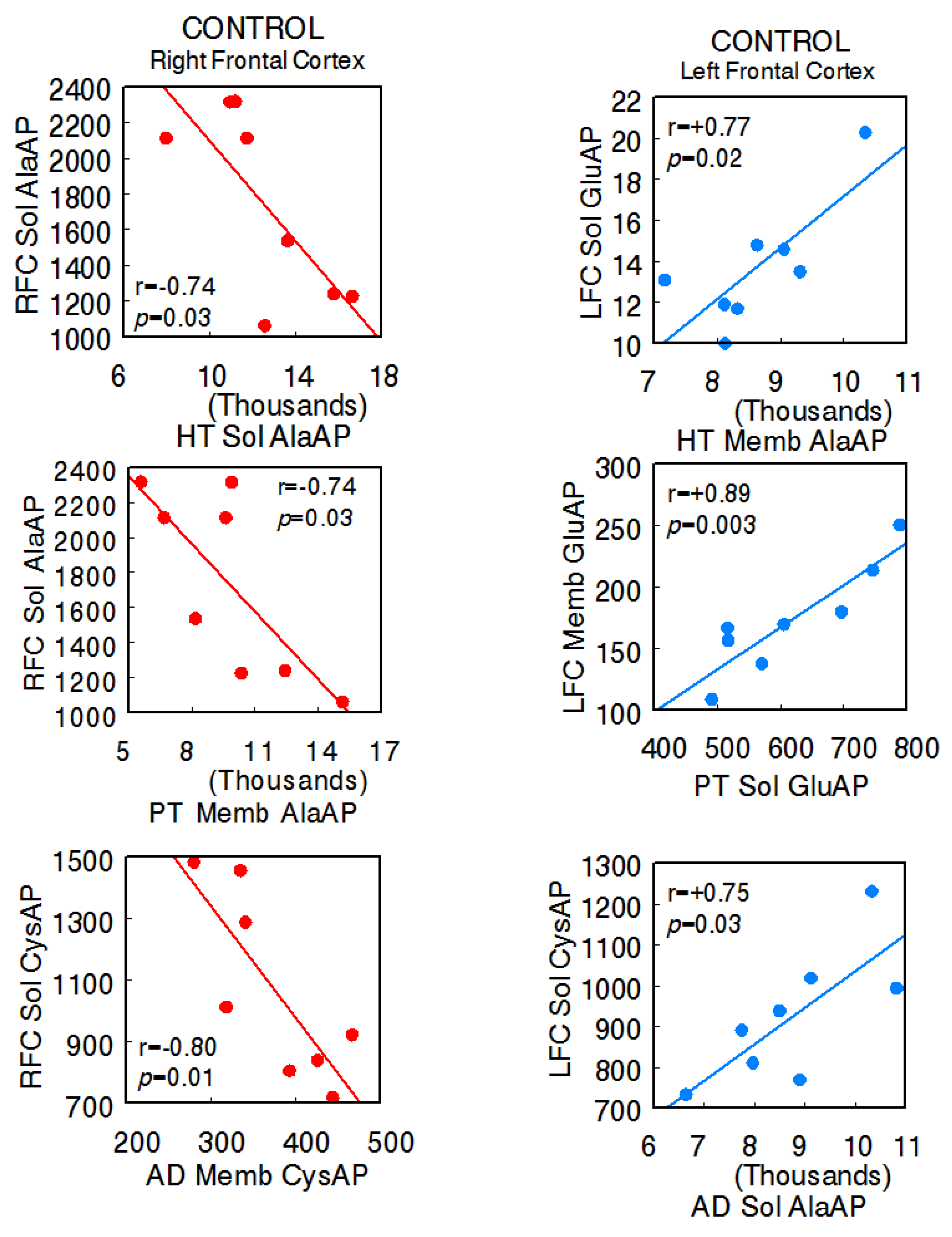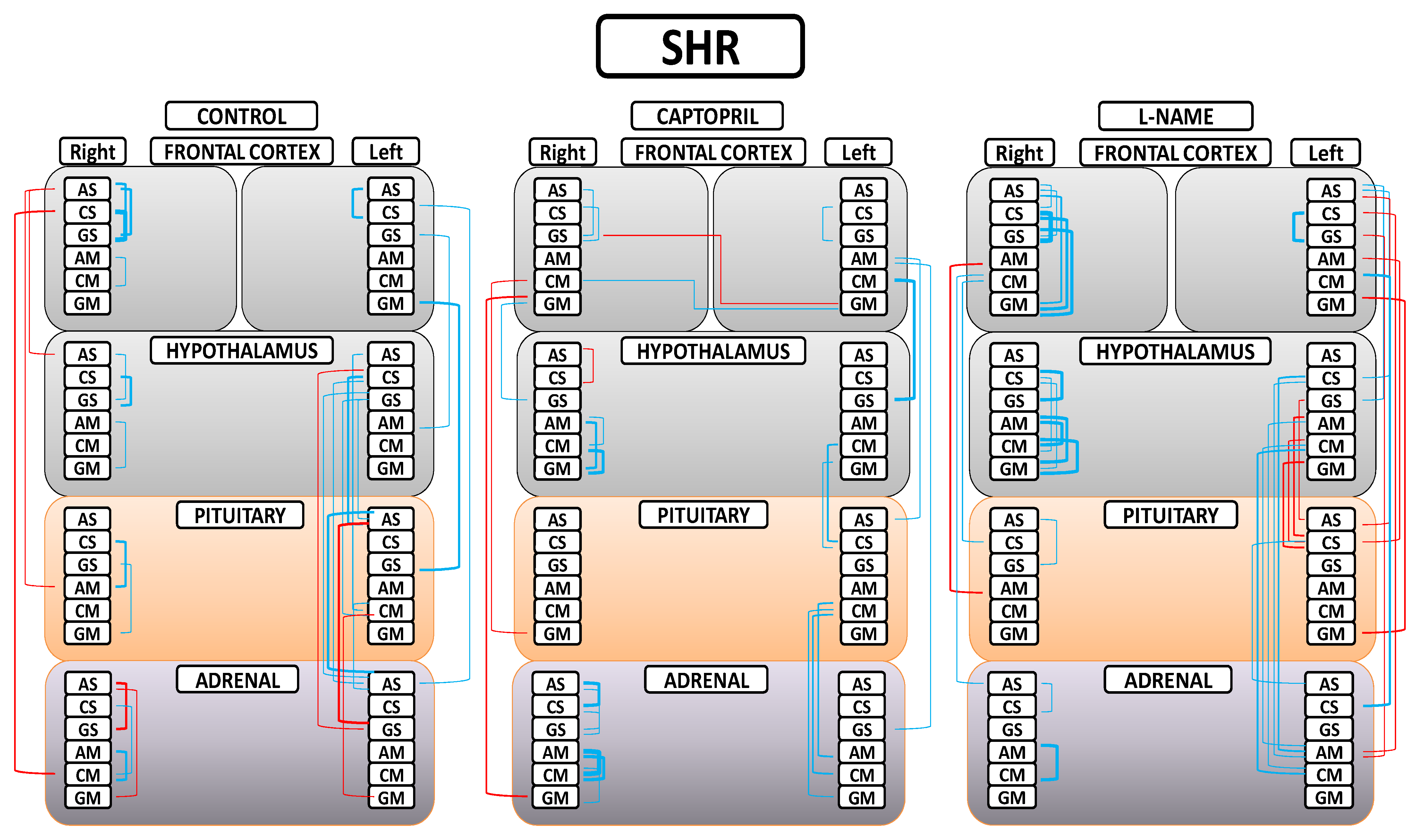Correlational Study of Aminopeptidase Activities between Left or Right Frontal Cortex versus the Hypothalamus, Pituitary, Adrenal Axis of Spontaneously Hypertensive Rats Treated with Hypotensive or Hypertensive Agents
Abstract
:1. Introduction
1.1. Role of Aminopeptidases in the Renin–Angiotensin System
1.2. Objectives
2. Results
3. Discussion
4. Materials and Methods
4.1. Animals, Treatments, Blood Pressure Determination, and Ethical Approval
4.2. Surgical Procedure and Obtaining Tissue Samples
4.3. Methods for the Determination of Proteins and Enzymatic Activities
4.4. Statistical Analysis
5. Conclusions
Supplementary Materials
Author Contributions
Funding
Institutional Review Board Statement
Informed Consent Statement
Data Availability Statement
Conflicts of Interest
References
- Cleland, S.J.; Reid, J.L. The renin-angiotensin system and the heart: A historical review. Heart 1996, 76, 7–12. [Google Scholar] [CrossRef] [PubMed]
- Karamyan, V.T.; Speth, R.C. Enzymatic pathways of the brain renin-angiotensin system: Unsolved problems and continuing challenges. Regul. Pept. 2007, 143, 15–27. [Google Scholar] [CrossRef]
- Smith, R.; Thayer, J.F.; Khalsa, S.S.; Lane, R.D. The hierarchical basis of neurovisceral integration. Neurosci. Biobehav. Rev. 2017, 75, 274–296. [Google Scholar] [CrossRef] [PubMed]
- Hagemann, D.; Waldstein, S.R.; Thayer, J.F. Central and autonomic nervous system integration in emotion. Brain Cogn. 2003, 52, 79–87. [Google Scholar] [CrossRef] [PubMed]
- Patel, S.; Rauf, A.; Khan, H.; Abu-Izneid, T. Renin-angiotensin-aldosterone (RAAS): The ubiquitous system for homeostasis and pathologies. Biomed. Pharmacother. 2017, 94, 317–325. [Google Scholar] [CrossRef]
- Jackson, L.; Eldahshan, W.; Fagan, S.C.; Ergul, A. Within the Brain: The Renin Angiotensin System. Int. J. Mol. Sci. 2018, 19, 876. [Google Scholar] [CrossRef]
- Yang, R.; Smolders, I.; De Bundel, D.; Fouyn, R.; Halberg, M.; Demaegdt, H.; Vanderheyden, P.; Dupont, A.G. Brain and peripheral angiotensin II type 1 receptors mediate renal vasoconstrictor and blood pressure responses to angiotensin IV in the rat. J. Hypertens. 2008, 26, 998–1007. [Google Scholar] [CrossRef]
- Hallberg, M. Targeting the insulin-regulated aminopeptidase/AT4 receptor for cognitive disorders. Drug News Perspect. 2009, 22, 133–139. [Google Scholar] [CrossRef]
- Mustafa, M.R.; Dharmani, M.; Kunheen, N.K.; Sim, M.K. Effects of des-aspartate-angiotensin I on the actions of angiotensin III in the renal and mesenteric vasculature of normo- and hypertensive rats. Regul. Pept. 2004, 120, 15–22. [Google Scholar] [CrossRef]
- Sim, M.K.; Radhakrishnan, R. Novel central action of des-Asp-angiotensin I. Eur. J. Pharmacol. 1994, 257, R1–R3. [Google Scholar] [CrossRef]
- Radhakrishnan, R.; Sim, M.K. Actions of D-amino acid-substituted analogues of des-Asp-angiotensin I on the central pressor action of angiotensin III. Eur. J. Pharmacol. 1995, 294, 337–339. [Google Scholar] [CrossRef] [PubMed]
- Fricker, L.D.; Margolis, E.B.; Gomes, I.; Devi, L.A. Five Decades of Research on Opioid Peptides: Current Knowledge and Unanswered Questions. Mol. Pharmacol. 2020, 98, 96–108. [Google Scholar] [CrossRef] [PubMed]
- Hui, K.-S. Neuropeptidases. In Handbook of Neurochemistry and Molecular Neurobiology: Neural Protein Metabolism and Function; Lajtha, A., Banik, N., Eds.; Springer: Berlin/Heidelberg, Germany, 2007; Volume 7, pp. 625–652. [Google Scholar]
- Prieto, I.; Segarra, A.B.; Villarejo, A.B.; de Gasparo, M.; Martínez-Cañamero, M.M.; Ramírez-Sánchez, M. Neuropeptidase activity in the frontal cortex of Wistar-Kyoto and spontaneously hypertensive rats treated with vasoactive drugs: A bilateral study. J. Hypertens. 2019, 37, 612–628. [Google Scholar] [CrossRef] [PubMed]
- Prieto, I.; Villarejo, A.B.; Segarra, A.B.; Banegas, I.; Wangensteen, R.; Martinez-Cañamero, M.; de Gasparo, M.; Vives, F.; Ramírez-Sánchez, M. Brain, heart and kidney correlate for the control of blood pressure and water balance: Role of angiotensinases. Neuroendocrinology 2014, 100, 198–208. [Google Scholar] [CrossRef]
- Segarra, A.B.; Prieto, I.; Banegas, I.; Martínez-Cañamero, M.; Villarejo, A.B.; Domínguez-Vías, G.; de Gasparo, M.; Ramírez-Sánchez, M. Interaction between Angiotensinase Activities in Pituitary and Adrenal Glands of Wistar-Kyoto and Spontaneously Hypertensive Rats under Hypotensive or Hypertensive Treatments. Int. J. Mol. Sci. 2021, 22, 7823. [Google Scholar] [CrossRef]
- Sander, M.; Hansen, P.G.; Victor, R.G. Sympathetically mediated hypertension caused by chronic inhibition of nitric oxide. Hypertension 1995, 26, 691–695. [Google Scholar] [CrossRef]
- Segarra, A.B.; Prieto, I.; Banegas, I.; Villarejo, A.B.; Wangensteen, R.; de Gasparo, M.; Vives, F.; Ramírez-Sánchez, M. Asymmetrical effect of captopril on the angiotensinase activity in frontal cortex and plasma of the spontaneously hypertensive rats: Expanding the model of neuroendocrine integration. Behav. Brain Res. 2012, 230, 423–427. [Google Scholar] [CrossRef]
- Segarra, A.B.; Prieto, I.; Banegas, I.; Villarejo, A.B.; Wangensteen, R.; de Gasparo, M.; Vives, F.; Ramírez-Sánchez, M. The brain-heart connection: Frontal cortex and left ventricle angiotensinase activities in control and captopril-treated hypertensive rats—A bilateral study. Int. J. Hypertens 2013, 2013, 156179. [Google Scholar] [CrossRef]
- Stuss, D.T.; Knight, R.T. Principles of Frontal Lobe Function. Oxford University Press: Oxford, UK, 2002. [Google Scholar]
- Hamilton, D.A.; Brigman, J.L. Behavioral flexibility in rats and mice: Contributions of distinct frontocortical regions. Genes Brain Behav. 2015, 14, 4–21. [Google Scholar] [CrossRef]
- Mundorf, A.; Ocklenburg, S. Hemispheric asymmetries in mental disorders: Evidence from rodent studies. J. Neural Transm. 2023, 130, 1153–1165. [Google Scholar] [CrossRef]
- McGinley, J.J.; Friedman, B.H. Autonomic responses to lateralized cold pressor and facial cooling tasks. Psychophysiology 2015, 52, 416–424. [Google Scholar] [CrossRef] [PubMed]
- Partadiredja, G.; Miller, R.; Oorschot, D.E. The number, size, and type of axons in rat subcortical white matter on left and right sides: A stereological, ultrastructural study. J. Neurocytol. 2003, 32, 1165–1179. [Google Scholar] [CrossRef] [PubMed]
- Wu, H.M.; Wang, C.; Wang, X.L.; Wang, L.; Chang, C.W.; Wang, P.; Gao, G.D. Correlations between angiotensinase activity asymmetries in the brain and paw preference in rats. Neuropeptides 2010, 44, 253–259. [Google Scholar] [CrossRef]
- Samara, A.; Vougas, K.; Papadopoulou, A.; Anastasiadou, E.; Baloyanni, N.; Paronis, E.; Chrousos, G.P.; Tsangaris, G.T. Proteomics reveal rat hippocampal lateral asymmetry. Hippocampus 2011, 21, 108–119. [Google Scholar] [CrossRef] [PubMed]
- Tayebati, S.K.; Tomassoni, D.; Amenta, F. Neuroinflammatory Markers in Spontaneously Hypertensive Rat Brain: An Immunohistochemical Study. CNS Neurol. Disord. Drug Targets 2016, 15, 995–1000. [Google Scholar] [CrossRef] [PubMed]
- Kim, J.H.; Afridi, R.; Cho, E.; Yoon, J.H.; Lim, Y.H.; Lee, H.W.; Ryu, H.; Suk, K. Soluble ANPEP Released from Human Astrocytes as a Positive Regulator of Microglial Activation and Neuroinflammation: Brain Renin-Angiotensin System in Astrocyte-Microglia Crosstalk. Mol. Cell Proteom. MCP 2022, 21, 100424. [Google Scholar] [CrossRef]
- Eshima, K.; Hirooka, Y.; Shigematsu, H.; Matsuo, I.; Koike, G.; Sakai, K.; Takeshita, A. Angiotensin in the nucleus tractus solitarii contributes to neurogenic hypertension caused by chronic nitric oxide synthase inhibition. Hypertension 2000, 36, 259–263. [Google Scholar] [CrossRef]
- Priviero, F.B.; Teixeira, C.E.; Claudino, M.A.; De Nucci, G.; Zanesco, A.; Antunes, E. Vascular effects of long-term propranolol administration after chronic nitric oxide blockade. Eur. J. Pharmacol. 2007, 571, 189–196. [Google Scholar] [CrossRef]
- Kiss, D.S.; Toth, I.; Jocsak, G.; Barany, Z.; Bartha, T.; Frenyo, L.V.; Horvath, T.L.; Zsarnovszky, A. Functional Aspects of Hypothalamic Asymmetry. Brain Sci. 2020, 10, 389. [Google Scholar] [CrossRef]
- Peterson, C.K.; Harmon-Jones, E. Circadian and seasonal variability of resting frontal EEG asymmetry. Biol. Psychol. 2009, 80, 315–320. [Google Scholar] [CrossRef]
- Slaiby, J.M.; Ricci, M.A.; Gadowski, G.R.; Hendley, E.D.; Pilcher, D.B. Expansion of aortic aneurysms is reduced by propranolol in a hypertensive rat model. J. Vasc. Surg. 1994, 20, 178–183. [Google Scholar] [CrossRef] [PubMed]
- Paxinos, G.; Watson, C. The Rat Brain in Stereotaxic Coordinates, 4th ed.; Academic Press: London, UK, 1998. [Google Scholar]
- Greenberg, L.J. Fluorimetric measurement of alkaline phosphatase and aminopeptidase activities in the order of 10–14 mole. Biochem. Biophys. Res Commun. 1962, 9, 430–435. [Google Scholar] [CrossRef]
- Tobe, H.; Kojima, F.; Aoyagi, T.; Umezawa, H. Purification by affinity chromatography using amastatin and properties of aminopeptidase A from pig kidney. Biochim. Biophys. Acta 1980, 613, 459–468. [Google Scholar] [CrossRef] [PubMed]
- Bradford, M.M. A rapid and sensitive method for the quantitation of microgram quantities of protein utilizing the principle of protein-dye binding. Anal. Biochem. 1976, 72, 248–254. [Google Scholar] [CrossRef] [PubMed]





Disclaimer/Publisher’s Note: The statements, opinions and data contained in all publications are solely those of the individual author(s) and contributor(s) and not of MDPI and/or the editor(s). MDPI and/or the editor(s) disclaim responsibility for any injury to people or property resulting from any ideas, methods, instructions or products referred to in the content. |
© 2023 by the authors. Licensee MDPI, Basel, Switzerland. This article is an open access article distributed under the terms and conditions of the Creative Commons Attribution (CC BY) license (https://creativecommons.org/licenses/by/4.0/).
Share and Cite
Prieto, I.; Segarra, A.B.; Banegas, I.; Martínez-Cañamero, M.; Durán, R.; Vives, F.; Domínguez-Vías, G.; Ramírez-Sánchez, M. Correlational Study of Aminopeptidase Activities between Left or Right Frontal Cortex versus the Hypothalamus, Pituitary, Adrenal Axis of Spontaneously Hypertensive Rats Treated with Hypotensive or Hypertensive Agents. Int. J. Mol. Sci. 2023, 24, 16007. https://doi.org/10.3390/ijms242116007
Prieto I, Segarra AB, Banegas I, Martínez-Cañamero M, Durán R, Vives F, Domínguez-Vías G, Ramírez-Sánchez M. Correlational Study of Aminopeptidase Activities between Left or Right Frontal Cortex versus the Hypothalamus, Pituitary, Adrenal Axis of Spontaneously Hypertensive Rats Treated with Hypotensive or Hypertensive Agents. International Journal of Molecular Sciences. 2023; 24(21):16007. https://doi.org/10.3390/ijms242116007
Chicago/Turabian StylePrieto, Isabel, Ana Belén Segarra, Inmaculada Banegas, Magdalena Martínez-Cañamero, Raquel Durán, Francisco Vives, Germán Domínguez-Vías, and Manuel Ramírez-Sánchez. 2023. "Correlational Study of Aminopeptidase Activities between Left or Right Frontal Cortex versus the Hypothalamus, Pituitary, Adrenal Axis of Spontaneously Hypertensive Rats Treated with Hypotensive or Hypertensive Agents" International Journal of Molecular Sciences 24, no. 21: 16007. https://doi.org/10.3390/ijms242116007
APA StylePrieto, I., Segarra, A. B., Banegas, I., Martínez-Cañamero, M., Durán, R., Vives, F., Domínguez-Vías, G., & Ramírez-Sánchez, M. (2023). Correlational Study of Aminopeptidase Activities between Left or Right Frontal Cortex versus the Hypothalamus, Pituitary, Adrenal Axis of Spontaneously Hypertensive Rats Treated with Hypotensive or Hypertensive Agents. International Journal of Molecular Sciences, 24(21), 16007. https://doi.org/10.3390/ijms242116007






